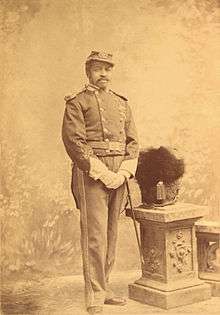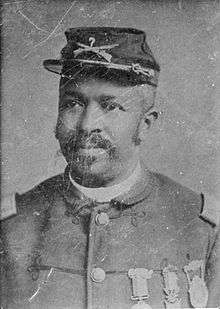Christian Abraham Fleetwood
Christian Abraham Fleetwood (July 21, 1840 – September 28, 1914), was an African American non-commissioned officer in the United States Army, an editor, a musician, and a government official. He received the Medal of Honor for his actions during the American Civil War.
Christian Abraham Fleetwood | |
|---|---|
 Christian Fleetwood | |
| Born | July 21, 1840 Baltimore, Maryland |
| Died | September 28, 1914 (aged 74) Washington, D.C. |
| Place of burial | Columbian Harmony Cemetery, Washington, D.C. |
| Allegiance | United States of America Union |
| Service/ | U.S. Army (Union Army) District of Columbia National Guard |
| Years of service | 1863–1897 |
| Rank | |
| Unit | 4th Regiment United States Colored Troops |
| Battles/wars | American Civil War |
| Awards | Medal of Honor |
| Other work | editor, musician, and politician |
Early life
Fleetwood was born in Baltimore on July 21, 1840, the son of Charles and Anna Maria Fleetwood, both were free persons of color.[1][2] He received his early education in the home of a wealthy sugar merchant and chairman of Baltimore's chamber of commerce, John C. Brunes, and his wife. The latter treated Fleetwood like her son and taught him to read and write.[2][3] He continued his education at the Maryland State Colonization Society,[1] went briefly to Liberia and Sierra Leone, and graduated in 1860 from Ashmun Institute (later known as Lincoln University) in Oxford, Pennsylvania.[2] He established and published The Lyceum Observer, said to be the first newspaper in the Upper South to be owned and operated by an African American.[1][3]
Civil War
When the American Civil War disrupted travel by ship to Liberia,[2] Fleetwood went to Baltimore's Camp Birney[1] and enlisted into Company G of the 4th Regiment United States Colored Infantry, Union Army, on August 11[3] or August 17, 1863.[2] Due to his educated background, Fleetwood was given the rank of sergeant upon enlistment and was promoted to sergeant major on August 19.[2][3] His regiment, assigned to the 3rd Division, saw service with the 10th, 18th, and 25th Army Corps in campaigns in North Carolina and Virginia, particularly on July 16, 1864, in the Battle of Petersburg[4] and on September 29–30, 1864, in the Battle of Chaffin's Farm.[2][4]
On September 29, 1864, the 3rd Division, including Fleetwood's regiment, participated in the Battle of Chaffin's Farm on the outskirts of the Confederate capital of Richmond, Virginia. During the 4th Regiment's charge on the enemy fortifications, Fleetwood supervised the unit's left flank.[4] Among the charging soldiers was Sergeant Alfred B. Hilton, the bearer of two flags, one of which had been seized from a wounded sergeant. When Hilton himself was wounded, Fleetwood and another soldier, Charles Veale, each grabbed a flag from him before the colors could touch the ground. Now carrying the American flag, Fleetwood continued forward under heavy fire until it became clear that the unit could not penetrate the enemy defenses. Retreating back to the reserve line, he used the flag to rally a small group of men and continue the fight. For their actions during the battle, Fleetwood, Hilton, and Veale were each issued the Medal of Honor just over six months later, on April 6, 1865. Fleetwood's official Medal of Honor citation reads simply: "Seized the colors, after 2 color bearers had been shot down, and bore them nobly through the fight."[5][6] The medal is now part of the collection of the Smithsonian's National Museum of American History.[7]
Although every officer of the regiment sent a petition for him to be commissioned an officer, Secretary of War Edwin Stanton did not recommend appointment.[2] Fleetwood was honorably discharged from the Army on May 4, 1866.[2] Fleetwood's 1864 service is in part detailed in a diary he wrote that year full of entries about his experiences during the war.[8]
Post-war life
After the war, Fleetwood worked as a bookkeeper in Columbus, Ohio, until 1867, and in several minor government positions in the Freedmen's Bank and War Department in Washington, D.C. With his wife Sara Iredell, whom he married on November 16, 1869, he led an active social life.[2] Sara Iredell's grandmother, Louisa Burr, was the sister of Philadelphia abolitionist John (Jean) Pierre Burr and daughter of U.S. Vice President, Aaron Burr.[9] Sara's maternal uncle, novelist Frank J. Webb, lived with the couple in Washington[10] in 1870 while writing for Frederick Douglass' New Era.[10] The Fleetwoods had one daughter, Edith.[11]
They were well acquainted with most of the prominent African Americans of the period, many who frequently visited their residence. Members of Washington's black elite society presented Fleetwood with a testimonial in 1889. He also organized a battalion of D.C. National Guardsmen and, in 1888, Washington, D.C.'s, Colored High School Cadet Corps.

It was his military career that probably inspired Fleetwood's interest in the Washington colored National Guard and the colored high school cadet corps. The Washington Cadet Corps, organized and commanded by Captain D. Graham on June 12, 1880, was expanded into the Sixth Battalion of D.C. National Guards on July 18, 1887, with Fleetwood appointed major and commanding officer. After reorganizations, several African American battalions were consolidated into the First Separate Battalion in 1891. Passed over as its commanding officer, Fleetwood resigned in 1892.[2]
Meanwhile, he and Major Charles B. Fisher, who had commanded the Fifth Battalion, were instrumental in organizing the Colored High School Cadet Corps of the District of Columbia in 1888. Fleetwood, the first instructor of the colored high school cadets, served until 1897, when he was succeeded by Major Arthur Brooks. These two officers developed a tradition of military service among young colored men in Washington which led some of them to enlist in World War I and others to be commissioned at the Colored Officers Training Camp in Fort Des Moines, Iowa.
Fleetwood never returned to active duty with any military organization. However, many residents of the District of Columbia recommended that he be appointed as the Commander of the 50th U.S. Colored Volunteer Infantry during the Spanish–American War. This request was not seriously considered by the War Department, and the participation of colored soldiers from the District of Columbia was similarly disregarded. It is not known whether Fleetwood's short stature and physical ailments reduced his chances for consideration. His army records state that he was five feet, four and one half inches tall. These records also state that he applied in 1891 for a pension because of "total" deafness in his left ear, the result of "gunshot concussion," and "severe" deafness in his right ear, the result of catarrh contracted while in the army.[12] His application also stated that these ailments prevented him from speaking or singing in public.
For a number of years he served as choirmaster of the 15th Street Presbyterian Church, St. Luke's and St. Mary's Protestant Episcopal Churches, as well as the Berean Baptist Church. Supported by the community, including the wives of former presidents (Lucy Webb Hayes and Frances Folsom Cleveland), his musical presentations were extremely successful.[13]
Death and legacy
He died suddenly of heart failure in Washington, D.C. on September 28, 1914, at age 74. Funeral services were held at St. Luke's Episcopal Church. Interment was in Columbian Harmony Cemetery, Washington, D.C.[14] The First Separate Battalion of D.C. National Guards served as escort at his funeral. Among the honorary pallbearers were such prominent Washingtonians as Arthur Brooks, Daniel Murray, Whitefield McKinlay, and Judge Robert H. Terrell. The participation by the National Guard, and by Arthur Brooks in particular, was an appropriate recognition of the most significant aspects of Fleetwood's career.[15] His remains were moved to National Harmony Memorial Park when Columbia Harmony Cemetery closed in 1959.[16]
Medal of Honor citation
Rank and organization: Sergeant Major, 4th U.S. Colored Troops, Place and date: At Chapin's Farm, Va., September 29, 1864. Entered service at: ------. Birth: Baltimore, Md. Date of issue: April 6, 1865.[17]
His citations reads:
The President of the United States of America, in the name of Congress, takes pleasure in presenting the Medal of Honor to Sergeant Major Christian A. Fleetwood, United States Army, for extraordinary heroism on 29 September 1864, while serving with 4th U.S. Colored Infantry, in action at Chapin's Farm, Virginia. Sergeant Major Fleetwood seized the colors, after two Color Bearers had been shot down, and bore them nobly through the fight.[17]
See also
- List of African American Medal of Honor recipients
- List of American Civil War Medal of Honor recipients: A–F
Notes
- Jefferson, Robert F., Jr (October 26, 2018). Brothers in Valor: Battlefield Stories of the 89 African Americans Awarded the Medal of Honor. Rowman & Littlefield. pp. 7–9. ISBN 978-1-4930-3175-7.
- Reef, Catherine (May 14, 2014). African Americans in the Military. Infobase Publishing. pp. 89–90. ISBN 978-1-4381-0775-2.
- Clifford, James H. (September 22, 2017). "Sergeant Major Christian Fleetwood – The Campaign for the National Museum of the United States Army". Army Historical Foundation. Archived from the original on February 8, 2020. Retrieved February 8, 2020.
- Martin, James B. (May 12, 2014). "Fleetwood, Christian". In Martin, James B. (ed.). African American War Heroes. ABC-CLIO. pp. 68–71. ISBN 978-1-61069-366-0.
- Beyer, W. F.; Keydel, O.F., eds. (2000). Deeds of Valor: How America's Civil War Heroes Won the Congressional Medal of Honor. New York: Smithmark Publishers. pp. 434–435. ISBN 978-0-7651-1769-4.
- "Civil War Medal of Honor recipients, A–L". Medal of Honor recipients. United States Army Center of Military History. Archived from the original on September 1, 2019. Retrieved September 6, 2010.
- "Medal of Honor, Christian A. Fleetwood". CivilWar@Smithsonian. Smithsonian Institution. Retrieved August 27, 2008.
- Diary of Sergeant Major Christian A. Fleetwood, 1864, excerpts. National Humanities Center Resource Toolbox, The Making of African American Identity: Vol I, 1500–1865, http://nationalhumanitiescenter.org/pds/maai/identity/text7/fleetwooddiary.pdf
- Maillard 2013, p. 273.
- Maillard, Mary (2013). "'Faithfully Drawn from Real Life': Autobiographical Elements in Frank J. Webb's The Garies and Their Friends". The Pennsylvania Magazine of History and Biography. 137 (3): 292. JSTOR 10.5215/pennmaghistbio.137.3.0261.CS1 maint: ref=harv (link)
- Harley, Sharon (1997). "Fleetwood, Sara Iredell (1849–1908)". In Hine, Darlene Clark; Thompson, Kathleen (eds.). Facts on File Encyclopedia of Black women in America. Internet Archive. New York: Facts on File. pp. 72–73. ISBN 9780816034284. OCLC 35209436.
- Cochran, Anthony B. (October 12, 2018). Out of the Storm: A Legacy. Outskirts Press. pp. 58–59. ISBN 978-1-9772-0039-6.
- Johnson, Charles, Jr. (2005). "Fleetwood, Christian". In Appiah, Anthony; Gates, Henry Louis (eds.). Africana: The Encyclopedia of the African and African American Experience. Oxford University Press. pp. 662. ISBN 978-0-19-517055-9.
- Martin, James B. (2014). "Fleetwood, Christian". In Martin, James B. (ed.). African American War Heroes. Santa Barbara, Calif.: ABC-CLIO. p. 70. ISBN 978-1610693660.
- "Army Veteran Paves the Way for African Americans in the Military." Armed Forced Retirement Home. January 31, 2008, p. 7. Archived October 7, 2012, at the Wayback Machine Accessed October 28, 2012.
- Harris, Hamil R.; Smith, Leef (May 27, 1997). "On Memorial Day, Soldiers and Citizens Honor Sacrifices of Those Who Fought for Freedom". The Washington Post. p. B12.
- Kurin, Richard (October 25, 2016). The Smithsonian's History of America in 101 Objects. Penguin. p. 227. ISBN 978-0-14-312815-1.
External links

- Works by or about Christian Abraham Fleetwood at Internet Archive
- Don Morfe (January 21, 2003). "Christian Abraham Fleetwood". Claim to Fame: Medal of Honor recipients. Find a Grave. Retrieved September 6, 2010.
- "Christian Abraham Fleetwood". Hall of Valor. Military Times. Retrieved September 6, 2010.
- "Fleetwood, Christian, U.S. National Park Service". Retrieved September 24, 2010.